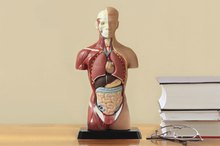What Human Body Systems Work With the Immune System?
The immune system is responsible for protecting the body against invasion by diseases and other pathogens including viruses, bacteria and parasites. The immune system is also involved in the normal healing response to trauma as a protection against infection. Although the body is an integrated whole and all systems work together to some extent, the major body systems that work with the immune system are the lymph, circulatory, musculoskeletal and digestive systems.
Thymus
The thymus is a specialized organ and is part of the immune system. The thymus is located beneath the sternum and is active only in young people. It can be thought of as the immune training ground for the maturing body where immune cells learn to differentiate pathogens from self.
Lymph System
Differences Between Blood Vessels & Lymph Vessels
Learn More
It is through the lymph system that the body moves fluids outside the blood and circulatory system. The lymph is the major pathway for the circulation of immune cells and immune signals. It contains thousands of lymph nodes where immune cells sample and respond to invading pathogens. Tonsils, the appendix and gut-associated lymph tissues (GALT) are similar to lymph nodes and are more specialized organs the body uses to develop and moderate immune responses.
- It is through the lymph system that the body moves fluids outside the blood and circulatory system.
- The lymph is the major pathway for the circulation of immune cells and immune signals.
Circulatory System
The circulatory system consists of the blood vessels and heart and is a major pathway used by immune cells to travel through the body.
Musculoskeletal System
3 Major Cell Types
Learn More
It is through the movement of muscles that lymph is moved throughout the body. This is one of the major reasons regular exercise is critical to healthy immune function. The marrow of the long, flat bones in the body is where blood cells, including the immune cells, grow and mature before entering the circulatory and lymph systems.
Digestive System
The digestive system is critical to proper immune function. The GALT, including the tonsils and appendix, are locations where the body deciphers which foreign substances are food and which are pathogens, helping to create normal immune function.
Other Systems
Along with the four major systems, the respiratory, nervous and endocrine systems are highly involved with immune function. The lungs are integrally involved with exposure of the immune system to pathogens and, like the digestive system, have large amounts of immune tissues. The nervous and endocrine systems share many of the same signaling chemicals as the immune system and along with the immune system are essential to the body's balance and homeostasis (ability to maintain internal equilibrium).
Related Articles
References
- "Gray's Anatomy: The Anatomical Basis of Clinical Practice;" S. Standring (Editor); 2008
- "Basic Pathology, 6th Edition;" R.S. Cotran et al.; 1997
- Children's Health and the Environment. October 2011. WHO Training Package for the Health Sector World Health Organization.
- Peter J. Delves. Autoimmune Disorders. Merk Manuals.
Writer Bio
Dr. Drew Scott is a naturopathic doctor practicing in Portland, Ore., as a family physician and health consultant. Dr. Scott writes on health and lifestyle related subjects and is an avid proponent of developing and practicing good choices today for a healthy and vibrant future.









